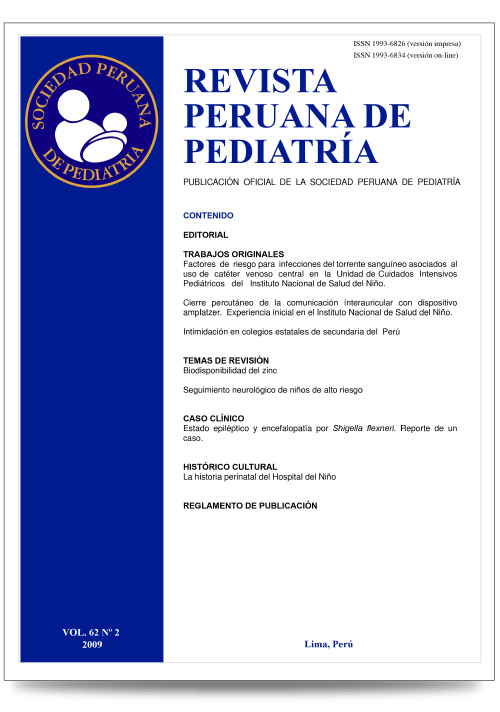Percutaneous closure of interatrial communication with the amplatzer device. Initial experience at the Instituto Nacional de Salud del Niño
DOI:
https://doi.org/10.61651/rped.2009v62n2p62-67Keywords:
Heart Septal Defects, Atrial, Heart Defects, Congenital, Septal Occluder DeviceAbstract
Objective: Describe the evolution of 5 to 16 years old patients who underwent a percutaneous closure of type Ostium Secundum Interatrial Communication (OS-IAC) with the Amplatzer device at the Instituto Nacional de Salud del Niño.
Material and methods: From 2006 July to 2007 December, 15 patients with OS-IAC, defined by transthoracic echocardiogram (TTE), underwent a transoesophageal echocardiogram (TEE) and 8 patients with criteria for percutaneous closure were selected and also underwent a cardiac catheterism. An informed consent was obtained in all cases.
Results: Most of the patients (7/8) were girls, with ages between 5 to 16 years, and I and II functional class. All the procedures were carried out in a hemodynamic ward, under general anesthesia; the average time average was 75 minutes. The interauricular communication average size was 15.4 mm, and the more used Amplatzer device was Number 20. Success rate was 87.5% (7/8).
The average stay hospital was 1.5 days. There were not any complications. At 6-month follow-up all patients were asyntomatic.
Conclusions: Percutaneous closure of the auricular communication with the amplatzer device is a safety procedure, with short hospital stay and no complications.
Downloads
Downloads
Published
How to Cite
Issue
Section
Categories
License
Copyright (c) 2009 Carlos Mariño Vigo, César Salinas Mondragón, María Lapoint Montes, Manuel Laura, Fredy Prada, Carlos Pedra, Teresa Velazco, Isabel Zárate, Samia Sánchez

This work is licensed under a Creative Commons Attribution 4.0 International License.
Authors will retain the copyright and grant the right to publish their work in the journal while allowing third parties to share it under the Creative Commons Attribution license.
Articles are published under a Creative Commons license that allows sharing and adaptation with appropriate credit. CC BY 4.0 license. Available in English at https://creativecommons.org/licenses/by/4.0/
Authors may use other information disclosure formats as long as the initial publication in the journal is cited. The dissemination of the work through the Internet is recommended to increase citations and promote academic exchanges.
The published content does not necessarily reflect the specific point of view of the journal, and the authors assume full responsibility for the content of their article.




